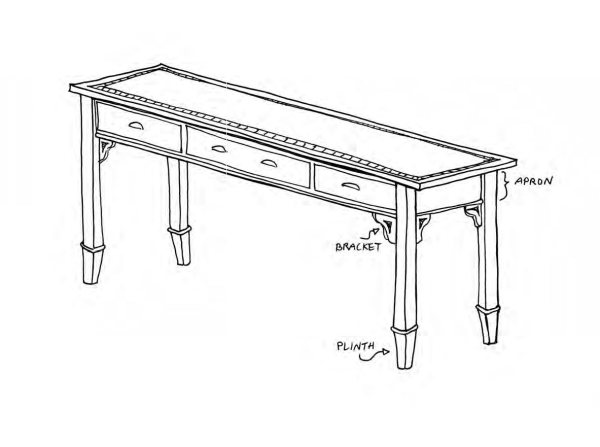
“By Hound and Eye” isn’t for everyone. If you’re a geometry whiz or an 18-century cabinet maker, you probably won’t learn anything new from the workbook. I’ve created a three-question quiz to help each blog reader decide whether or not “By Hound and Eye” will be worth its $20 price tag to you ($10 for the pdf alone):
- Do you already use a sector and a divider to layout your designs?
- Can you readily produce a set of full-scale measured drawing from the sketch of the writing desk below?
- Can you write out the musical harmony literally embedded in the desk below?
If you answered “yes” to all three questions, “By Hound and Eye” might underwhelm you.

I probably should have learned all of these skills two years ago when I first picked up “By Hand and Eye.” But I didn’t. Tolpin and Walker’s prose was so eloquent that I imagined I was already seeing “the music frozen in furniture.” Thanks to their persuasiveness, I became a haughty, complacent reader. I didn’t do the exercises on page 28, let alone the dozens suggested in the following 150 pages.

By the final section, I felt completely underwhelmed by the simplicity of the projects, which seemed so straightforward that any electron-slaying woodworker could produce each of them in just a long afternoon. Instead of seeing design proportions, I saw easy joinery. Instead of hearing music, just the hum of my table saw.
 In “By Hound and Eye,” Walker and Tolpin take the inverse approach. Instead of telling you about the music of furniture, they teach you how to read and write your own. After my first time through the book, I still cannot answer “yes” to questions 1 and 3 above. And I never had a singular “aha” moment of the sort Chris described. But I imagine I will, once I work my way through them another three or four times. This is math, after all, and translating theory into skills takes multiple rounds of practice (at least for me).
In “By Hound and Eye,” Walker and Tolpin take the inverse approach. Instead of telling you about the music of furniture, they teach you how to read and write your own. After my first time through the book, I still cannot answer “yes” to questions 1 and 3 above. And I never had a singular “aha” moment of the sort Chris described. But I imagine I will, once I work my way through them another three or four times. This is math, after all, and translating theory into skills takes multiple rounds of practice (at least for me).
 A final note: If you’re one of those brave souls who has already broken free of the rectangularity of arts-and-crafts designs, you might benefit particularly from Section III of the workbook, “Curves.” It was in those pages that I felt most inspired and, paradoxically, still more than a little ignorant.
A final note: If you’re one of those brave souls who has already broken free of the rectangularity of arts-and-crafts designs, you might benefit particularly from Section III of the workbook, “Curves.” It was in those pages that I felt most inspired and, paradoxically, still more than a little ignorant.
——————————
Image credits: Author’s photograph of hand forged dividers by Seth Gould; detailed crop from Raphael’s masterpiece “The School of Athens,” Images from By Hound and Eye, illustrated by Andrea Love.